C++类与对象(2)
类与对象
- 类的默认成员函数
-
- 初始化和清理:
-
- 构造函数:
- 析构函数:
- 析构函数和构造函数的调用顺序:
- 拷贝构造函数
- 赋值运算符重载
-
- 运算符重载:
- 赋值运算符重载:
- const成员
-
- const修饰类的成员函数
- 取地址及const取地址操作符重载
类的默认成员函数
初始化和清理:
- 构造函数主要完成初始化工作
- 析构函数主要完成清理工作
构造函数:
我们可以举一个关于日期的简单例子:
#include对于Date类,可以通过SetDate公有的方法给对象设置内容,但是如果每次创建对象都调用该方法设置信息,未免有点麻烦,我们可以通过构造函数进行在对象创建时,就将信息设置进去。
构造函数是一种特殊的成员函数,名字与类名相同,创建类类型对象时由编译器自动调用,保证每个数据成员都有一个合适的初始值,并且在对象的生命周期内只调用一次。
构造函数的特征:
- 函数名与类名相同。
- 无返回值。
- 对象实例化时编译器自动调用对应的构造函数。
- 构造函数可以重载。
- 构造函数也是类中的一个成员函数。
- 构造函数通常被声明为共有函数。
- 作为类的成员函数,构造函数可以直接访问类中的所有数据类型,构造函数可以是内联函数,也可以带有参数表,可以带默认的形参值,也可以重载。(重载形式有两种:有参和无参构造。)
eg:利用无参构造方法如下:
#includeeg:利用缺省值或半缺省的方法进行实现默认日期
class Date
{
public:
Date(int year=2022,int month=1,int day=1)
{
_year = year;
_month = month;
_day = day;
}
void Display()
{
cout << _year <<"-" << _month <<"-" << _day << endl;
}
private:
int _year;
int _month;
int _day;
};
int main()
{
Date d1;
d1.Display();
Date d2(2022, 1, 26);
d2.Display();
return 0;
}
class Time
{
public:
Time()
{
cout << "Time()" << endl;
_hour = 0;
_minute = 0;
_second = 0;
}
private:
int _hour;
int _minute;
int _second;
};
class Date
{
private:
int _year;
int _month;
int _day;
Time _t;
};
int main()
{
Date d;
return 0;
}
总结:
- C++里面把类型分为两类:内置类型(基本类型),自定义类型
- 内置类型:int/char/double/指针/内置类型数组 等等
- 自定义类型:struct/class定义的类型
- 我们不写编译器默认生成构造函数,对于内置类型不做初始化处理
- 对于自定类型成员变量会去调用它的默认构造函数初始化,如果没有默认构造函数就会报错
- 任何一个类的默认构造函数就是–不用参数就可以调用。
- 任何一个类的默认构造函数有三个,全缺省、无参、我们不写编译器默认生成的。
析构函数:
概念: 与构造函数功能相反,析构函数不是完成对象的销毁,局部对象销毁工作是由编译器完成的,对象在销毁时会自动调用析构函数,完成类的一些资源的清理工作。
- 析构函数是特殊的成员函数。
析构函数的特征: - 析构函数名是在类名前面加上字符~
- 无参数无返回值
- 一个类有且只有一个析构函数,若未显示定义,系统会自动生成默认的析构函数。
- 对象生命周期结束时,C++编译系统自动调用析构函数。
- 析构函数不接受任何形参、但可以是虚函数。
给出以下代码如下:
typedef int DataType;
class SeqList
{
public:
SeqList(int capacity = 10)
{
_pData = (DataType*)malloc(capacity * sizeof(DataType));
assert(_pData);
_size = 0;
_capacity = capacity;
}
~SeqList()
{
if (_pData)
{
free(_pData);
_pData = nullptr;
_capacity = 0;
_size = 0;
}
}
private:
int* _pData;
size_t _size;
size_t _capacity;
};
class Date
{
public:
Date(int year = 0, int month = 1, int day = 1)
{
_year = year;
_month = month;
_day = day;
}
~Date()
{
cout << "~Date()" << endl;
}
private:
int _year;
int _month;
int _day;
};
int main()
{
Date d1(2022, 1, 26);
return 0;
}
关于编译器自动生成的析构函数,是否会完成一些事情呢?下面的程序我们会看到,编译器生成的默认
析构函数,对会自定类型成员调用它的析构函数。
class String
{
public:
String(const char* str = "jack")
{
_str = (char*)malloc(strlen(str) + 1);
strcpy(_str, str);
}
~String()
{
cout << "~String()" << endl;
free(_str);
}
private:
char* _str;
};
class Person
{
public:
private:
String _name;
int _age;
};
int main()
{
Person per;
return 0;
}
析构函数同构造函数一样,对于内置类型成员变量不做处理,对于自定义成员变量回去调用它的析构函数。
析构函数和构造函数的调用顺序:
- 类的析构函数调用一般按照构造函数的相反顺序进行调用,但是要注意static对象的存在,因为static改变了对象的生存作用域,需要等待程序结束时才会析构释放对象。
- 全局对象先于局部对象进行构造
- 局部对象按照出现的顺序进行构造,无论是否为static
- 析构的顺序按照构造的相反顺序析构,只需要注意static改变对象的生存作用域之后,会放在局部对象之后进行析构。
- 析构函数和构造函数的调用顺序就好比栈的原则:先进后出。所以顺序相反。
分析如下代码所示:
#include根据上面的分析可知:
构造顺序为:C A B D
析构顺序为:B A D C
验证如下:
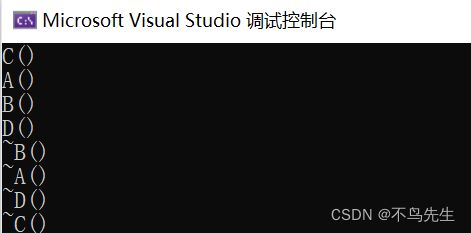
拷贝构造函数
构造函数:只有单个形参,该形参是对本类类型对象的引用(一般常用const修饰),在用已存在的类类型对象
创建新对象时由编译器自动调用。
属于构造函数,所以无返回值。
生成一个对象的副本有两种用途:
- 建立一个新对象。
- 将一个已有对象的数据成员值取出来,一一赋给新对象。
拷贝构造函数也是特殊的成员函数,其特征如下:
- 拷贝构造函数是构造函数的重载形式之一。
- 拷贝构造函数的参数只有一个且必须使用引用传参,使用传值方式会无限递归下去。
复制构造函数是一种特殊的构造函数,具有一般构造函数的所有特征,其形参是本类的对象引用。其作用是使用一个已经存在的对象(由复制构造函数的参数指定),去初始化同类的一个新对象。
如果没有定义类的复制构造函数,系统就会在必要时自动生成一个隐含的复制构造函数。这个隐含的复制构函数的功能是:把初始值对象的每一个数量成员的值都复制到新建的对象中。
分析代码如下:
class Point
{
public:
Point()
{
}
Point(int x, int y)
{
_x = x;
_y = y;
}
Point(Point& p);
int GetX()
{
return _x;
}
int GetY()
{
return _y;
}
private:
int _x, _y;
};
Point::Point(Point& p)
{
_x = p._x;
_y = p._y;
cout << "Calling the copy constructor." << endl;
}
普通的拷贝构造是在对象的创建时被调用,而复制构造函数在一下 三种情况会被调用。
- 当用类中的一个对象去初始化类中的另一个对象时:
void Test1()
{
Point a(1, 2);
Point b(a);
Point c = a;
cout << b.GetX()<< endl;
}
- 如果函数的形参是类的对象,调用函数时,进行形参和实参结合:
void f(Point p)
{
cout << p.GetX() << endl;
}
void Test2()
{
Point a(1, 2);
f(a);
}
- 如果函数的返回值是类的对象,函数执行完成返回调用者:
Point g()
{
Point a(1, 2);
return a;
}
void Test3()
{
Point b;
b = g();
}
分析如下代码所示:
class Date
{
public:
Date(int year = 2022, int month = 1, int day = 1)
{
_year = year;
_month = month;
_day = day;
}
Date(const Date& d) //带引用,传别名 ,不能直接传值(会无限递归下去)
{
_year = d._year;
_month = d._month;
_day = d._day;
}
void Display()
{
cout << _year << "-" << _month << "-" << _day << endl;
}
private:
int _year;
int _month;
int _day;
};
int main()
{
Date d1;
d1.Display();
Date d2(d1);
d2.Display();
return 0;
}
为什么不能用传值构造:
调用拷贝构造函数:需要先传参数,传参传值又是一个拷贝构造,依次无限递归下去。
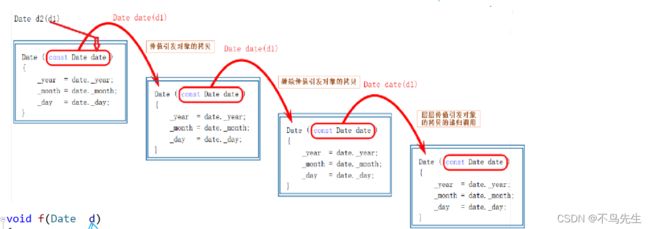
浅拷贝(值拷贝): 若未显示定义,系统生成默认的拷贝构造函数。默认的拷贝构造函数对象按内存存储按字节完成拷贝,这种拷贝我们叫做浅拷贝,或者值拷贝。
默认生成拷贝构造:
- 浅拷贝: 内置类型成员,会完成按照字节序的拷贝。
- 深拷贝: 自定义类型成员,会调用其他的拷贝构造。
如下代码显示:
class Date
{
public:
Date(int year = 2022, int month = 1, int day = 1)
{
_year = year;
_month = month;
_day = day;
}
void Display()
{
cout << _year << "-" << _month << "-" << _day << endl;
}
private:
int _year;
int _month;
int _day;
};
int main()
{
Date d1;
d1.Display();
// 这里d2调用的默认拷贝构造完成拷贝,d2和d1的值也是一样的。
Date d2(d1);
d2.Display();
return 0;
}
深拷贝代码如下:
class String
{
public:
String(const char* str = "jack")
{
_str = (char*)malloc(strlen(str) + 1);
strcpy(_str, str);
}
void Display()
{
cout << _str << endl;
}
~String()
{
cout << "~String()" << endl;
free(_str);
}
private:
char* _str;
};
int main()
{
String s1("hello");
s1.Display();
String s2(s1);
s2.Display();
return 0;
}
运行结果如下:
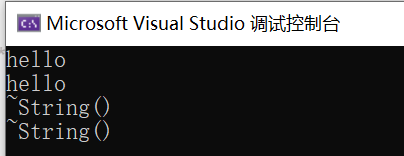
其中第一个~String()是s2的、第二String()是s1的。
第二的例子:
class Stack
{
public:
Stack(int capacity = 4)
{
_a = (int*)malloc(sizeof(int) * capacity);
if (_a == nullptr)
{
cout << "malloc fail." <<endl;
exit(-1);
}
_top = 0;
_capacity = capacity;
}
~Stack()
{
free(_a);
_a = nullptr;
_top = _capacity = 0;
}
private:
int* _a;
size_t _top;
size_t _capacity;
};
int main()
{
Stack st1(10);
Stack st2(st1);
return 0;
}
赋值运算符重载
运算符重载:
C++中为了增强代码的可读性引入了运算符重载,运算符重载是具有特殊函数名的函数, 也具有其返回值类型,函数名字以及参数列表、以及参数列表、其返回值类型与参数列表与普通的函数类似。
函数名字为:关键字operator后面接需要重载的运算符符号。
注意:
- 不能通过连接其他符号来创建新的操作符:比如operator@
- 重载操作符必须有一个类类型或者枚举类型的操作数。
- 用于内置类型的操作符,其含义不能改变。例如:内置的整型+,不能改变其含义。
- 作为类成员的重载函数是,其形参看起来比操作数数目少1的成员函数的操作符有一个默认的this,限定为第一个形参。
- . 、:: 、sizeof 、?: 、.* 注意以上五个运算符不能重载。
运算符重载实例:
class Date
{
public:
Date(int year = 1900, int month = 1, int day = 1)
{
_year = year;
_month = month;
_day = day;
}
// bool operator==(const Date* this, const Date& d2)
// 这里需要注意的是,左操作数是this指向的调用函数的对象
bool operator==(const Date& d2)
{
return _year == d2._year;
&& _month == d2._month
&& _day == d2._day;
}
private:
int _year;
int _month;
int _day;
};
void Test ()
{
Date d1(2022, 1, 29);
Date d2(2022, 1, 30);
cout<<(d1 == d2)<<endl;
}
赋值运算符重载:
class Date
{
public :
Date(int year = 1900, int month = 1, int day = 1)
{
_year = year;
_month = month;
_day = day;
}
Date (const Date& d)
{
_year = d._year;
_month = d._month;
_day = d._day;
}
Date& operator=(const Date& d)
{
if(this != &d)
{
_year = d._year;
_month = d._month;
_day = d._day;
}
}
private:
int _year ;
int _month ;
int _day ;
};
赋值运算符特征:
- 参数类型
- 返回值
- 检测是否自己给自己赋值
- 返回* this
- 一个类如果没有显示定义赋值运算符重载,编译器也会生成一个,完成对象按字节序的值拷贝。
注意: 拷贝构造和赋值构造之间的区别:
拷贝构造: 一个已经存在的对象拷贝初始化一个马上创建实例化的对象。
赋值构造: 两个已经存在的对象之间进行赋值拷贝。
void Test()
{
Date d1(2022, 1, 27);
Date d2(2022, 1, 28);
Date d3(2022, 1, 29);
//一个已经存在的对象拷贝初始化一个马上创建实例化的对象。
Date d4(d1);//拷贝构造
Date d5 = d1;//拷贝构造
//两个已经存在的对象之间进行赋值拷贝
d2 = d1 = d3;
}
const成员
const修饰类的成员函数
将const修饰的类成员函数称之为const成员函数,const修饰类成员函数,实际修饰该成员函数的隐含的this指针, 表明在该成员函数中不能对类的任何成员进行修改。

思考:
- const对象可以调用非const成员函数吗?
- 非const对象可以调用const成员函数吗?
- const成员函数内可以调用其它的非const成员函数吗?
- 非const成员函数内可以调用其它的const成员函数吗?
根据一下代码可知:
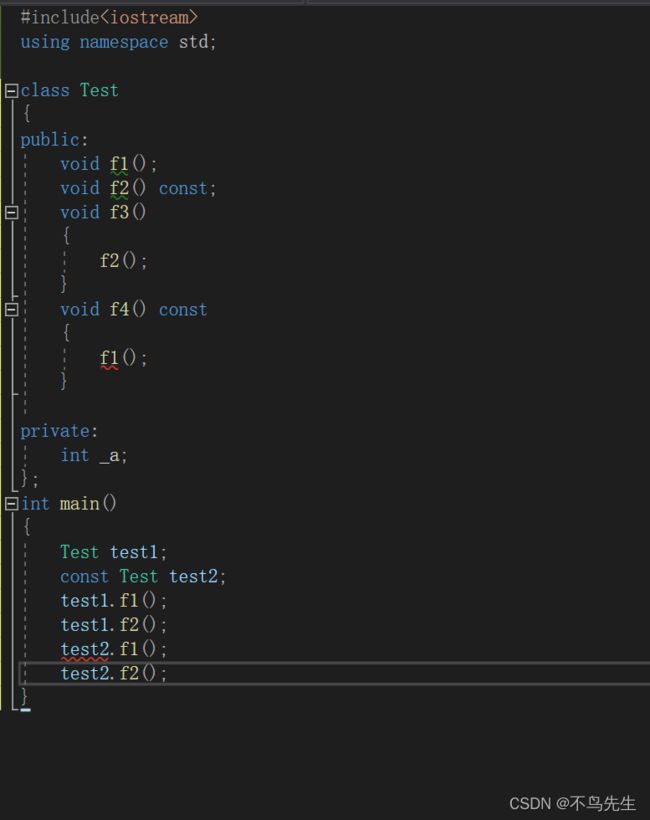
给出一下结论: - const对象可以调用const成员函数。
- const对象不能调用非const成员函数。
- 非const对象可以调用const成员函数。
- 非const对象可以调用非const成员函数。
- const成员函数不能调用非const成员函数。
- 非const成员函数可以调用非const成员函数。
1、若const对象想调用非const成员函数,则需要进行强制类型转换const_cast
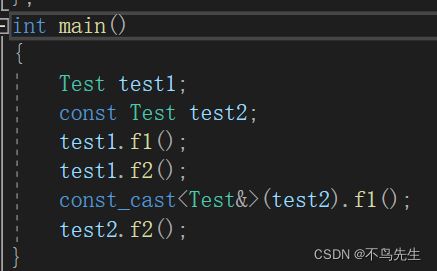
**2. 若const成员函数想调用非const成员函数,则需要对this指针进行强制类型转换const_cast
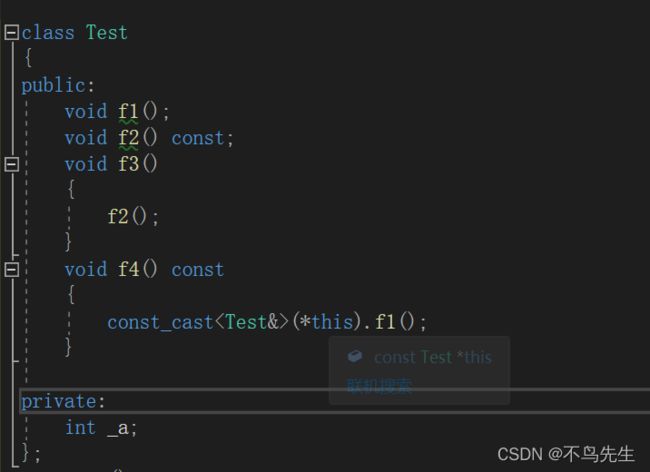
小结论:
1、非const对象(成员函数)即可以调用const对象(成员函数),也可以调用非const对象(成员函数)
2、const对象(成员函数)只能调用const对象(成员函数),想调用非const对象(成员函数)就需要强转
取地址及const取地址操作符重载
注意: 这两个默认成员函数一般不用重新定义 ,编译器默认会生成。
class Date
{
public :
Date* operator&()
{
return this ;
}
const Date* operator&()const
{
return this ;
}
private :
int _year ; // 年
int _month ; // 月
int _day ; // 日
};





